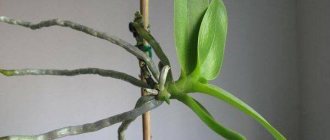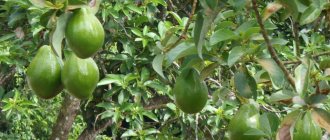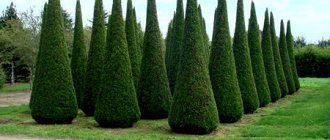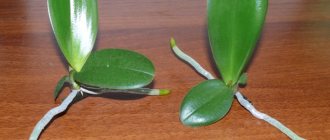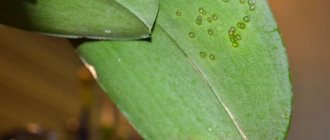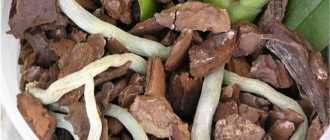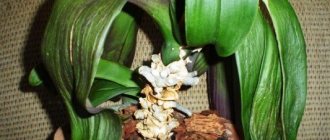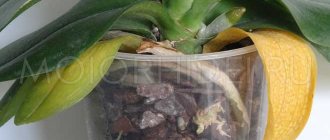Orchids (Phalaenopsis) are native to the rainforests of southeast Asia, the Philippines and northeastern Australia. In nature, these are epiphytes and lithophytes; they cling with their roots to other, mainly woody plants and rocks. When grown indoors, Phalaenopsis retained the natural pattern of root growth in the form of weakly twisting shoots, and therefore they are often confused with peduncles, which in the first stages of development have similar features. Let's look at how the peduncle of an orchid appears, how to distinguish it from the root, kids, and why it is important.
What is a peduncle
Peduncles in orchids are shoots that form from below on the above-ground part and grow upward. After the formation of a peduncle, flowers bloom on it. When the arrow just begins its formation, it is easy to confuse it with the roots or children of the epiphyte, since there are very few differences. Therefore, it is important to be able to distinguish the peduncle from the root of a phalaenopsis or its offspring.
To distinguish the peduncle of an orchid from the root and children, pay attention to the following signs:
- the roots have a rounded shape, and the flower arrows are cone-shaped;
- a flower arrow can be distinguished from a basal arrow after a while, when it grows a little, the shape of its tip becomes like a boat;
- the central vein of the leaf becomes the place of formation of the flower arrow;
- usually the arrow forms in the same place where there was flowering before;
- The main difference between the peduncle and other parts of the plant are the buds that bloom on it after final formation.
The flower stem at any stage of development is covered with irregularities in the form of scales or small spines. They are dormant buds.
It is the peduncle that is responsible for the beauty of the orchid. After all, over time, buds form and flowers bloom on it. In its upper part there is a green tip, which represents a growth point. As long as it is alive, new flowers will appear on the stem.
The new arrow broke
- Do not leave a broken arrow on the plant, do not glue it with tape, adhesive tape, or bandage it.
- Cut with sharp and sterile scissors 1–2 cm above the dormant bud. There is a high probability that a lateral peduncle will form from the dormant bud.
- If the peduncle breaks at the root, then you need to cut it off completely, trying to leave a small stump 1-2 cm high.
- Sprinkle the cut area with cinnamon or crushed activated carbon.
- A broken arrow can be placed in water, changing it periodically. An orchid can begin to bloom this way.
To prevent such cases from reoccurring, it is necessary to provide the plant with a habitat in which the likelihood of causing mechanical damage to the flower will be reduced to zero. Since plastic pots are quite unstable, it is advisable to place them in pots that are more stable: glass or ceramic.
Care before the appearance of the peduncle of the orchid and during the growth period
Until an arrow appears on the epiphyte, cultivation is carried out according to standard rules. The flower is provided with diffused lighting. To do this, it is moved from the southern window sill in mid-spring. Water the plant so that the soil dries out for several days between irrigations. This will enable the root system to take part in the process of photosynthesis.
The plant is provided with an influx of fresh air and at the same time protected from drafts. Cold is especially dangerous for orchids in winter. Damaged parts cannot be healed. Therefore, frozen tissues are cut out. Air humidity in the room is maintained at least 65%. During this period, the flower is regularly fed with special fertilizers marked “For orchids.” Others are not suitable for epiphytes because they burn the root system.
During the formation of the flower arrow, the care of the epiphyte changes. Therefore, it is important to know how to care for an orchid when it has released a peduncle.
After the orchid has a peduncle, irrigation is reduced. But at the same time, the flower is not subjected to overdrying. To do this, increase the interval between watering for drying to 5 days instead of 2-3 under the usual cultivation regime. Then the orchid is watered not once a week, but twice a month.
While the orchid’s peduncle is growing, the addition of nutrients is reduced. Fertilizing is completely abandoned when the plant begins to form buds. If this is not done, flowering will be short.
If the orchid has put out an arrow in the fall or winter, the pot is moved to the south side. If this is not possible, additional lighting will be provided. Otherwise, the shoot will stop developing. For good development, the arrows maintain the air temperature in the room from +23 to +26 degrees. Lower temperatures reduce the growth rate and cause the arrow to dry out.
Important!
The number, size and color of the buds largely depend on how carefully the plant was cared for in the last 120 days before the formation of the stem. If fertilizing is applied only at the moment the peduncle appears, there will be no abundant flowering.
Where does it grow from?
Many gardeners are interested in how an orchid produces a peduncle. The arrow develops from the axil of the orchid leaf. Sometimes it appears from the growth point. Other shoots that emerge from the stem or other zones are children or roots.
Sticky drops on orchid leaves: causes and treatment methods
The arrow is formed during the next flowering from the bud of an old branch. It grows away from the main stem and is accompanied by weak bud formation. The rapid development of the peduncle indicates proper care.
Note! Sometimes the arrow stops developing. Then it may turn yellow and dry out. The reason may be a lack of light and nutrition.
It is worth considering that normal lighting, fertilization and watering help the shoots to form correctly. The flowers that form on them reach impressive sizes.
Orchids can bloom at different times depending on their age. The peduncle is unlikely to emerge from a young rosette. Some plants begin to bloom at the 3rd year, others at an older age.
The duration of flowering is influenced by the type of orchid. There are varieties that bloom all year round, regardless of the seasonal factor. In any case, it is worth considering the type of flower:
- on phalaenopsis, flower stalks bloom all year long if properly cared for;
- Cymbidium blooms from October to the end of winter;
- Dendrobium blooms from mid-autumn until January.
If the substrate is not moistened in a timely manner, flowers with an arrow may dry out. Nutrient deficiency negatively affects shoot length. Peduncles grow well in diffused light and high humidity. When buds form, fertilization should be stopped. Otherwise, the decorative properties of the plant are reduced.
The arrow is formed from the bud of an old shoot
Growth Characteristics
In ordinary phalaenopsis, the peduncle grows for 2 months. Hybrid varieties produce flower stalks longer. Their formation period takes 3 months. During this time, the newly hatched stem turns into a full-fledged arrow. Depending on the growth conditions of the Phalaenopsis orchid, the interval may increase or decrease.
When provided with the right amount of light, sufficient humidity, warmth and nutrients, the growth process is 2 times faster. The side stems grow even faster and are fully formed in 1.5 months.
Typically, an orchid produces 2 to 3 flower stems. Sometimes in florist shops you can find plants with a lot of arrows. At home, the number of flower stalks is determined by the growing conditions of the plant and its care.
After the orchid shoots, it is important that it grows evenly and looks beautiful during flowering. To do this, perform the following steps:
- When the arrow grows to a length of 20 cm and is strong, it is fixed vertically.
- An orchid with a peduncle must be tied to a support using a special clothespin. If you don’t have one, use a regular hair tie or crab clips.
- If it is impossible to tie the flower stem, the pot is regularly unfolded as the arrow develops. Then it will reach out to the light and grow in the right direction.
Instructions on how to get a smooth escape
Having made sure that it is the flowering stem that is developing, it must be tied up in a vertical position in order to grow an even and tall peduncle. The recommendations will help make the shoot straight, tall, and prevent the branch from breaking.
Instructions for the orchid to give an even arrow:
- in a container with phalaenopsis, a support is installed for the growing peduncle;
- a strengthened and grown arrow 16-18 cm long is fixed vertically to a support, using a special clothespin for flowers;
- if the stem deviates to the side and it is not tied, then it is necessary to turn the pot with a flower branch towards the light, it will gradually level out.
Attention!
The lateral stem develops faster; it grows in a month and a half.
How to prevent a stop in the development of the arrow
When a flower stalk appears on the plant, it is important to create comfortable conditions. Then the arrow will constantly develop and will not stop developing. To do this, it is important to ensure that the lighting does not decrease. If the length of daylight hours has decreased, additional illumination with phyto-paws is organized.
Waterings are gradually reduced and the interval between them is increased. It is important not to overdry the plant. The temperature in the room is maintained at the optimal level for good growing season. Fertilizers are applied on time in accordance with the attached instructions.
Why doesn't the orchid bloom?
Mostly people buy already flowering specimens, but it also happens that they buy a plant without buds. It’s good if it releases a flower arrow after some time, but sometimes the waiting period is prolonged. A possible reason could be the youth of the plant. Different types of orchids bloom at the age of 1 to 3 years. For a plant to bloom, it must have 5 to 8 leaves.
The second reason for the reluctance to bloom is too calm and comfortable life. Of course, all lovers of indoor plants provide their pets with the best conditions. Therefore, they see no reason to reproduce. To make the exotic beauty bloom, give it a little shock: move it to another place, reduce watering, provide a contrast between day and night temperatures.
You can learn more about how to make an orchid bloom from this video:
How to make phalaenopsis shoot arrows at the same time
Usually an orchid produces only one arrow on which flowers form. You can grow several flower stalks only on an adult plant that has from 8 to 10 leaves in a rosette. Such an orchid often produces 2-3 flower stems, but it is not capable of throwing out more than three.
By expelling several flower arrows, the plant is stressed. Then, after abundant flowering, the orchid will begin to hurt, and it will develop a loss of strength. Therefore, experienced gardeners do not advise artificially stimulating the plant to form more than two stems.
Pests and diseases
A sick plant is not able to form an arrow. Among the main diseases affecting the peduncle are:
- Powdery mildew. The drug Skor or a solution of colloidal sulfur is used as treatment.
- Gray rot. A fungicide will help in the fight against it.
- Anthracnose. The disease is treated with the drugs Ritomil and Mikasan.
Pests can also cause the lack of arrows. Common harmful insects are:
- Mealybug. The affected plant is treated with a soap solution.
- Shield. Actellik solution is used for treatment.
- Thrips. These insects are destroyed using the drug Fitoverm.
Possible problems
Sometimes the peduncle of an epiphyte does not grow for a long time or the arrow has grown incorrectly. Often, flower growers with little experience break the flower stem. In this case, you need to understand the cause of the problem and determine actions to solve it.
Photo
The presented photos clearly demonstrate the modification of the orchid peduncle throughout its life, as well as the difference between the flowering shoot and the baby and roots.
Actions after flowering is completed
When the flowering period ends, caring for the flower depends on the condition of the flower stem. If the shoot turns yellow and shows signs of drying, it is cut off at the very base. The resulting wound is sprinkled with crushed charcoal or ground cinnamon to prevent infection. You can use chalk for the same purpose.
When the stem itself is green and the apical bud has dried up, the stem is shortened. The cut is made slightly above the first living bud. Exposed fabrics are treated with cinnamon, charcoal or chalk for disinfection.
If there are no signs of wilting or drying on the stem, it stands green, with healthy buds. After the end of the dormant period, buds will again form on such a stem and flowers will bloom. Therefore, you don't need to do anything with it.

